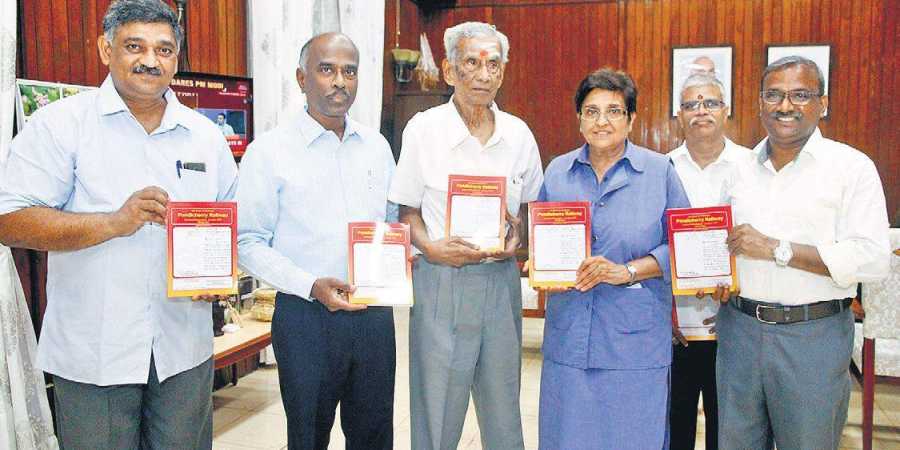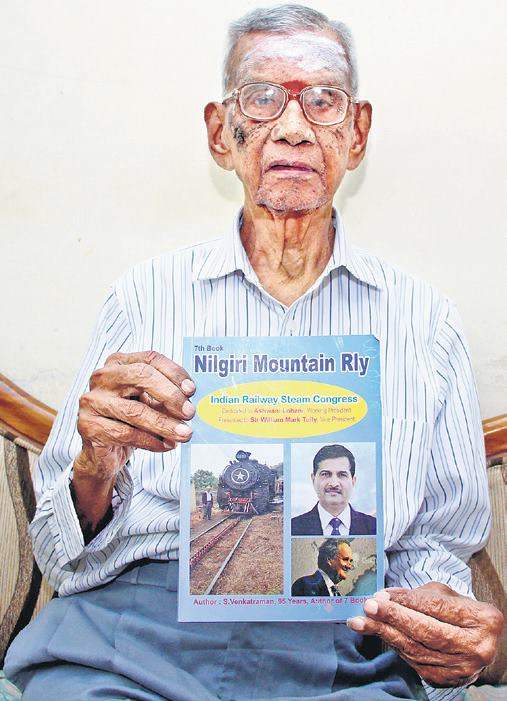Seven books and 40 years of service. Meet Srinivasa Venkatraman, a 95-year-old retired railway historian, whose child-like enthusiasm and energy defy age.

Chennai :
Seven books and 40 years of service. Meet Srinivasa Venkatraman, a 95-year-old retired railway historian, whose child-like enthusiasm and energy defy age. Dressed in a formal shirt and pant, his eyes gleam through a pair of brown glasses as he vividly narrates his life story. “These books are my prized possessions.
Anybody working on railway projects, PhD topics and preparing for UPSC examinations will find them to be important resource materials. The topmost railway officials and general managers have appreciated my work. I hope to take these books to the shelves of railway museums, libraries, hospital and other public spheres in the future. My books will help youngsters respect the heritage,” says the nonagenarian.

Madras to Varanasi
A resident of Mylapore, Venkatraman joined the Madras Southern Mahratta railway in 1942 as the materials manager. His job was to receive materials required for the trains and distribute them to other station masters. He was stationed at Hubli, one of the biggest workshops of those times, where locomotives used to be given for service, till 1944.
Soon, he was transferred to Madras. The railway board in Delhi then was looking to recruit 100 people across the country with five from each state. Venkatraman cleared the test and moved to the national Capital and worked there between 1944-1956. “My wife Lalitha Venkatraman and I completed our Bachelors in arts degree in Delhi. I enrolled for evening classes at Birla Mandir. I’d pass on the books to my wife who studied at home.
That was the time when steam engines were replaced by diesel engines. I requested for a transfer to Varanasi where a huge diesel locomotive workshop was set up. My wife completed her MA in Political Science at Banaras Hindu University. That motivated me to get my own Masters in Political Science from Tribhuvan University in Kathmandu. She went on to pursue her PhD in the same subject. We lived our golden period between 1957-1982 in Varanasi and I retired as a stores officer there,” shares Venkatraman, who continued to stay in Varanasi for another 20 years and came back to Chennai in 2008.
Fame at 90
After his retirement in 1985, Venkatraman used to write several articles for the Indian Railway Magazine every once in three to six months. He learned how to write a footnote, gather research materials and collect books from his wife who was actively involved with her PhD lectures. In 2013, he penned his first book Indian Railways- the Beginning. After an overwhelming response, he published his second book Indian Railways at a glance in 2014.
But, given the volume of information, Srinivasa had to simplify it through four subsequent books — The Madras Railway (2014), The Goa Railway (2015), PM Modi- the Indian Railways (2016) and The Pondicherry Railway (2017). Every book has a set of pictures, extensive history and images of preserved documents from the times of Britishers. The latest book on The Nilgiris Mountain Railway will be launched at the rail museum in New Delhi by BBC correspondent Mark Tully on November 18. The book is dedicated to the current chairman of Indian Railway Board, Ashwani Lohani.
“I type 20 pages a day. My four children were concerned about my health. I spent most of my time on the trains, covered more than 1,000 stations and lived like a nomad. Despite the one-man army effort there was not much of a recognition or empathy at all.
After a point, it became emotional and physically draining. Sourcing of information and rare documents from national archives was a daunting task. My motive is to preserve these heritage documentations not for fame but for my own satisfaction. Even when I sleep, the determination to pen another book constantly keeps me awake,” says Venkatraman.
Memorable trips
“Every Sunday there’s a train from Chennai to Goa. My favourite rail route has always been from Goa to Londa (a town in Karnataka). I must have taken that route at least a 1,000 times. One such experience was through Braganza Ghat, a stretch of hill station at Goa-Karnataka border.
It is the steepest gradient in Indian railways. The way these Britishers have constructed the tracks, bridges and brake system is impeccable. The engines designed to function in hill stations have an excellent brake system and engine power. One engine pushes the other from behind and climbs up the hills. Sadly, we find it difficult to maintain these engines and keep them in a good condition.”
For details call Venkatraman on 9444444865
What’s your take on bullet trains in India?
Bullet trains are not required in the present circumstances. But in order to keep pace with America, China and Japan we may need it in the future. We have evolved from having tradition steam engines to diesel and eventually electric. On the downside, considering the exorbitant price of a bullet train, it might not be affordable. We need to make a foundation today to achieve something big in 10 years. It is a necessary evil after all.
If you were made the Railway minister what changes would you bring about?
The work culture has to be changed. Discipline must be enforced and punishments should be given. People take the Railways for granted. Unionism must be broken. We need to sack people if they’re not performing efficiently.
Rail routes that Indians must go on at least once
Mettupalayam-Ooty: This beautiful mountainous railway is worth seeing. The functioning is peculiar. Here, the engine from the back pushes the train forward. Kalka-Shimla: The toy train is a delight to watch considering the scenic path it takes. And, the Mumbai-Pune route.
Did you know?
● The Railways is the largest employer with a total of 1.4 million employees
● There are around 7,500 small and big stations in India
● The Southern Railways was created on April 14, 1951
● The first passenger train in South India ran from Royapuram to Wallajah road on July 1,1856
Source: tnpscthervupettagam.com
source: http://www.newindianexpress.com / The New Indian Express / Home> Cities> Chennai / by Vaishali Vijaykumar / Express News Service / November 08th, 2018